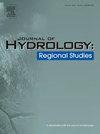An integrated framework for non-stationary hydrological drought assessment using time-varying parameter standardized streamflow index and time-varying threshold level method
IF 4.7
2区 地球科学
Q1 WATER RESOURCES
引用次数: 0
Abstract
Study region
Weihe River basin (WRB) in northern China.
Study focus
In a changing environment, traditional drought assessment methods may not be applicable when assumptions of stationarity are violated. Accordingly, this study proposes a framework that incorporates the time-varying parameter standardized streamflow index (SSIvar) and threshold level method (TLvar) for the non-stationary hydrological drought assessment. Then, the SSIvar and TLvar methods are compared with time-invariant and transplantation parameter SSI (SSIinvar and SSItran) and TL (TLinvar and TLtran) to validate their effectiveness.
New hydrological insights for the region
Validation results showed that SSIvar has the highest Kendall correlation coefficients with standardized precipitation index (SPI) and soil moisture index (SSMI) at 0.81 and 0.78, respectively, outperforming SSIinvar (0.67and 0.62) and SSItran (0.68 and 0.63). The TLvar method behaves in the same way, indicating that the SSIvar and TLvar methods provide a more accurate assessment of non-stationary hydrological drought. Furthermore, the comparison results show that the mean duration and severity of hydrological drought in the WRB increased by 22.37 % and 13.72 % for SSIvar method and 34.69 % and 19.15 % for TLvar method from 1961–1990 to 1991–2020, respectively, revealing that hydrological drought in the WRB has aggravated over the past 30 years. Overall, the combined use of SSIvar and TLvar provides a comprehensive understanding of non-stationary drought, integrating qualitative (e.g., severity levels) and quantitative (e.g., streamflow deficits) measures.
基于时变参数标准化流量指数和时变阈值水平法的非平稳水文干旱综合评价框架
中国北方渭河流域研究区域。研究重点在不断变化的环境中,传统的干旱评估方法在违反平稳性假设的情况下可能不适用。为此,本研究提出了一种结合时变参数标准化流量指数(SSIvar)和阈值水平法(TLvar)的非平稳水文干旱评价框架。然后,将SSIvar和TLvar方法与时不变和移植参数SSI (SSIinvar和SSItran)和TL (TLinvar和TLtran)进行比较,验证其有效性。验证结果表明,SSIvar与标准化降水指数(SPI)和土壤水分指数(SSMI)的肯德尔相关系数最高,分别为0.81和0.78,优于SSIinvar(0.67和0.62)和SSItran(0.68和0.63)。TLvar方法的表现与此相同,表明SSIvar和TLvar方法可以更准确地评估非平稳水文干旱。对比结果表明,1961-1990年和1991-2020年,水文干旱的平均持续时间(SSIvar)和严重程度(TLvar)分别增加了22.37 %和13.72 %,TLvar分别增加了34.69 %和19.15 %,表明近30 a来,WRB水文干旱有所加剧。总体而言,SSIvar和TLvar的联合使用提供了对非平稳干旱的全面理解,整合了定性(如严重程度)和定量(如流量赤字)措施。
本文章由计算机程序翻译,如有差异,请以英文原文为准。
求助全文
约1分钟内获得全文
求助全文
来源期刊

Journal of Hydrology-Regional Studies
Earth and Planetary Sciences-Earth and Planetary Sciences (miscellaneous)
CiteScore
6.70
自引率
8.50%
发文量
284
审稿时长
60 days
期刊介绍:
Journal of Hydrology: Regional Studies publishes original research papers enhancing the science of hydrology and aiming at region-specific problems, past and future conditions, analysis, review and solutions. The journal particularly welcomes research papers that deliver new insights into region-specific hydrological processes and responses to changing conditions, as well as contributions that incorporate interdisciplinarity and translational science.
 求助内容:
求助内容: 应助结果提醒方式:
应助结果提醒方式:


